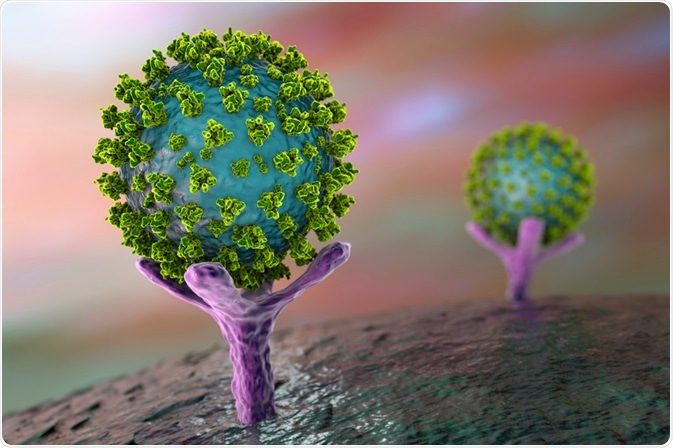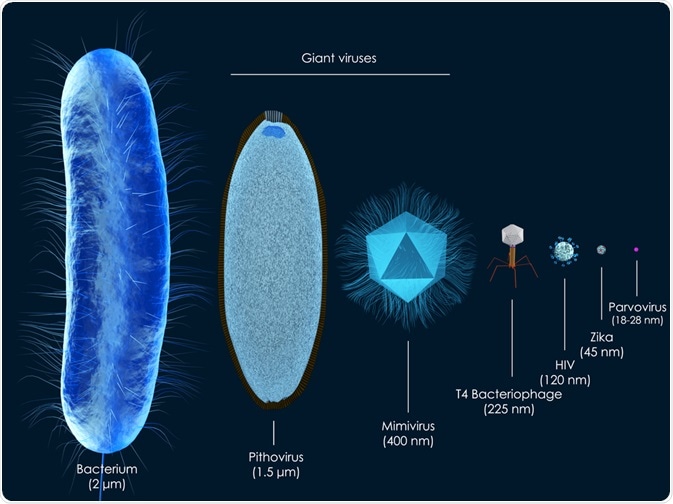The size of any viral or bacterial particle can provide a useful insight into how these infecting species can wreak havoc on host cells.

Image Credit: Kateryna Kon/Shutterstock.com
Size of SARS-CoV-2
Since the severe acute respiratory syndrome coronavirus 2 (SARS-CoV-2) was first identified in December of 2019, many infectious disease specialists, as well as researchers for almost every avenue of medicine, have been investigating how this virus spreads to and infects human beings, the wide range of severe health effects it can cause and ultimately what drugs will be able to effectively kill this virus safely.
In addition to mechanistic information, researchers have also evaluated the size and content characteristics of the SARS-CoV-2 particles. Upon analysis of negative-stained SARS-CoV-2 articles by electron microscopy, different researchers have had varying results, but the diameter of the virus has been found to range between 50 nm to 140 nm.
In addition to measuring the spherical size of the virus particle, it has also been confirmed that the length of the size tumors surrounding the outermost surface of SARS-CoV-2 can vary in length from 9 to 12 nm.
Why does size matter?
Around the world, health officials have agreed that wearing masks can prevent the spread of the virus between individuals. While this may be true, certain masks are considered much more effective at minimizing the risk of exposure, particularly N95 masks.
Whilst N95 masks from different producers may have slightly different specifications, the protective capabilities offered by N95 masks are largely attributed to the masks’ obligation to remove at least 95% of all particles with an average diameter of 300 nm or less.
The size of a virus particle largely determines how individuals can protect themselves and those around them from acquiring SARS-CoV-2. Knowing the size of a single virus particle can also allow researchers and healthcare providers to infer the amount of virus individuals are exposed to through different routes.
For example, respiratory droplets are typically 5-10 micrometers (µm) in length; therefore, it can be inferred that an individual who ingests, inhales, or is otherwise exposed to SARS-CoV-2 positive respiratory droplets can be exposed to hundreds or thousands of virus particles which increases the probability of infection.
Respiratory droplets can be transmitted through coughing, sneezing, contact with contaminated surfaces, or even through inhaled aerosols; therefore, each individual must take adequate steps to reduce their exposure to these particles by wearing masks and practicing safe social distance measures.
How does it compare to other viruses?
To date, research has shown that the viruses that have been identified and isolated can range in diameter size from 20 nm to as large as 500 nm. Aside from spherical virus particles like SARS-CoV-2, whose diameters provide information on their sizes, the length of rod- or filament-shaped viruses can measure to as long as 1,000 nm.
Viruses, particularly those that originate from animals like SARS-CoV-2, can differ greatly in their size. The smallest known animal viruses are icosahedrons, which belong to the Paroviridae and Picornaviridae families and can have a diameter ranging between 20 and 30 nm.
Comparatively, the largest and most complex virus currently known to man is the giant Mimivirus, which has a total particle diameter, of which includes the fibers that extend out from the capsid, of approximately 750 nm.

Image Credit: Meletios Verras/Shutterstock.com
Comparing bacteria and SARS-CoV-2 sizes
The SARS-CoV-2 virus is a much smaller particle compared to the primary models for bacterial cell biology, including Bacillus subtitles, Staphylococcus aureus, and Escherichia Coli and Caulobacter crescentus, all of which have a cell volume that ranges from 400 nm to as large as 3 µm (3000 nm).
The large size of such bacterial species often contribute to their diverse reproductive strategies and ultimately maximize their ability to produce and release large offspring.
Whilst size comparisons between viruses and bacteria can be useful to researchers, it is also useful to compare the size of SARS-CoV-2 to other things that are encountered daily. For example, a dust mite is typically 200 µm in size. If we take a 100 nm SARS-CoV-2 particle, this makes the dust mite 2000 times larger.
References
- Bar-On, Y. M., Flamholz, A., Phillips, R., & Milo, R. (2020). SARS-Cov-2 (COVID-19) by the numbers. eLife 9. doi:10.7554/eLife.57309.
- Levin, P. .A., & Angert, E R. (2015). Small but Mighty: Cell Size and Bacteria. Cold Spring Harbor Perspectives in Biology 7(7). doi:10.1101/cshperspect.a019216.
- Varga, Z.V. et al. (2020). Electron microscopy of SARS-CoV-2: a challenging task – Authors' reply. The Lancet 395(10238, E100). doi:10.1016/S0140-6736(20)31185-5.
- Wes Ser, D. R. (2010). Discovery of the Giant Mimivirus. Scitabe.
- “Modes of transmission of virus causing COVID-19: implications for IPC precaution recommendations. Scientific brief” – World Health Organization
- “Size and shape” – Britannia
Further Reading
Last Updated: Feb 15, 2021